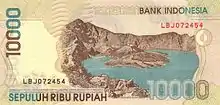Lake Segara Anak
Segara Anak is a crater lake in the caldera that formed during the explosive volcanic eruption of Mount Samalas in 1257. The caldera is next to Mount Rinjani on Lombok Island in Indonesia. "Segara Anak" means "child of the sea" and refers to the blue lake's resemblance to the sea. The volcanic cone Gunung Barujari is at the eastern end of the lake and is responsible for its crescent shape. The lake temperature is 20–22 °C (68–72 °F), which is 5-7 °C (9-13 °F) higher than normal for a lake at its altitude. Hot magma below the lake is responsible for this anomaly. Gas bubbles escape from the lake floor, helping the lake to have a pH of 7-8.[1]
| Segara Anak | |
|---|---|
 | |
 Segara Anak | |
| Location | Lombok Island |
| Coordinates | 8°25′00″S 116°28′00″E |
| Lake type | Crater lake |
| Basin countries | Indonesia |
| Surface area | 11.3 km2 (4.4 sq mi) |
| Max. depth | 190 m (620 ft) |
| Water volume | 36×106 m3 (1.3×109 cu ft) |
| Surface elevation | 2,004 m (6,575 ft) |
The surface of Segara Anak is 2,004 metres (6,575 ft) above mean sea level (AMSL) and is Indonesia's second-highest caldera lake with an active volcano. The peak of Gunung Baru Jari is 2,376 metres (7,795 ft) AMSL. The lake covers 45 square kilometres (17 sq mi), with dimensions of 7.5 by 6.0 kilometres (4.7 by 3.7 mi), and has a maximum depth of 230 metres (750 ft).[2]

Mount Samalas
The estimated height of Mount Samalas before its 1257 eruption was 4,200 metres (13,800 ft). According to a 2013 study, the eruption destroyed the mountain by ejecting up to 10 cubic miles (42 km3) of rock into the atmosphere. The eruption was one of the largest during the last few thousand years, with a probable Volcanic Explosivity Index of 7. The eruption may have been the cause of decreased global temperatures for a few years and may have even been a triggering factor for the Little Ice Age.[3][4][5]
References
- "The 2009 eruption of Rinjani volcano (Lombok, Indonesia)". Université Libre de Bruxelles. 2009-08-31. Retrieved 2020-12-17.
- "Lake Segara Anak: The Charm of Mt. Rinjani's Giant Caldera". TEMPO. 2016-11-29. Retrieved 2020-12-16.
- Lavigne, Franck; et al. (2013). "Source of the great A.D. 1257 mystery eruption unveiled, Samalas volcano, Rinjani Volcanic Complex, Indonesia". Proceedings of the National Academy of Sciences of the United States of America. 110 (42): 16742–16747. Bibcode:2013PNAS..11016742L. doi:10.1073/pnas.1307520110. PMC 3801080. PMID 24082132.
- Hamilton, Garry (2013-10-19). "The lost volcano". New Scientist: 39–41.
- Amos, Jonathan (2013-09-30). "Mystery 13th Century eruption traced to Lombok, Indonesia". BBC News. Retrieved 2020-12-17.
